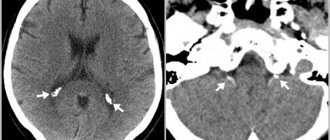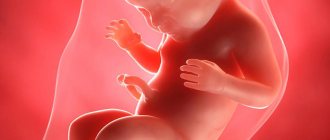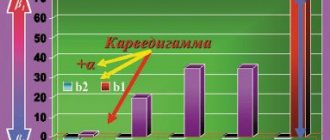Results and discussion
102 patients with unstable angina were under observation. Of these, 67 men and 45 women aged from 45 to 66 years (average age 53.8 ± 3.5 years). A history of myocardial infarction occurred in 87.5% of patients, stage II–III hypertension in 68%, diabetes mellitus in 12.8%, and obesity in 8% of subjects. Signs of stage II heart failure were diagnosed in 49% of patients. Almost the vast majority of patients experienced various non-fatal rhythm disturbances.
The examined patients were randomly divided into two groups of 51 people, comparable in age, severity and duration of the disease.
Common to all patients was the fact of destabilization of angina pectoris, characterized by increased frequency of attacks of anginal pain, decreased tolerance to physical activity, up to the appearance of anginal pain at rest. In addition, patients noted refractoriness to nitrates, which was expressed in an increased need for these drugs when stopping an anginal attack.
During their hospital stay, all patients received beta blockers (with the exception of 10 patients in whom destabilization was observed due to bradycardia), LMWH, antiplatelet agents (cardiomagnyl or clopidogrel), and statins. According to indications - diuretics, antiarrhythmic drugs, potassium and magnesium drugs, ATP inhibitors.
Patients in the main, or first, group, in addition to complex therapy, received Actovegin at a dose of 400 mg/day intravenously in 200 ml of saline. The injection rate is 2 ml/min.
In all examined patients, an electrocardiogram was assessed over time, an ultrasound examination of the heart (central hemodynamics) was performed, standard clinical and biological blood parameters, the frequency of anginal attacks, the number of nitroglycerin tablets taken, and exercise tolerance were determined. All of these parameters were assessed on the day of admission and before discharge of patients. The duration of treatment averaged 10.5 ± 1.2 days.
Compound
| Film-coated tablets | 1 table |
| core | |
| active substance: | |
| deproteinized hemoderivative of calf blood | 200 mg |
| excipients: magnesium stearate; povidone-K90; talc; MCC | |
| shell: acacia gum; mountain glycol wax; hypromellose phthalate; diethyl phthalate; quinoline yellow dye, aluminum varnish; macrogol-6000; povidone-K30; sucrose; talc; titanium dioxide |
Evaluation of clinical effectiveness
Analyzing the clinical condition of patients in both groups, we can draw the following conclusion: the inclusion of Actovegin in the basic therapy of patients with destabilized condition led to a decrease in the number of angina attacks by an average of 40 ± 6% per day compared to the control group, where the number of angina attacks decreased only by 20 ± 3% per day (P < 0.001). There was also a decrease in the number of additional nitroglycerin tablets from 10.5 ± 3 at the onset of the disease to 4.1 ± 2.1 by the fifth day of hospital stay; in the control group this figure was 11.4 ± 5.2 at the beginning and 6.2 ± 3.3 by the fifth day of treatment. This indicates an earlier onset of stabilization of the condition of patients in the main group. By the end of treatment, the number of nitroglycerin tablets taken in both groups was the same and averaged 1.1 and 1.3 tablets per day, respectively.
There was also a rapid (by the fifth day of treatment) reduction in the number of resting anginal attacks in the main group by 60%, while in the control group this figure was 45.5%. To be fair, it should be noted that 2 patients in the main group and 3 patients in the control group developed signs of acute myocardial infarction on the ECG on the third day of hospital stay, and these patients were transferred to a specialized department.
A clinical study revealed that taking Actovegin significantly improved the tolerability of nitrates - headaches decreased or disappeared after taking nitroglycerin, while simultaneously increasing its (nitroglycerin) effectiveness.
Along with a decrease in clinical manifestations of coronary blood flow instability, patients receiving Actovegin noted a decrease in morning headaches, tinnitus, and dizziness. Many (40%) patients in the main group paid attention to a decrease in anxiety, restlessness, normalization of sleep, and improved mood.
These data indicate a positive effect of the drug on the cerebral manifestations of coronary artery disease characteristic of patients with coronary artery disease.
Actovegin in the treatment of diseases of the nervous system
Treatment of patients with various neurological diseases with Actovegin has been discussed in a number of reviews [5,8,13,17]. Actovegin is a highly purified hemodialysate obtained by ultrafiltration from the blood of calves. The drug contains organic low-molecular compounds, which eliminates the development of prion diseases, such as Creutzfeldt-Jakob disease. The technology for producing Actovegin excludes the presence of protein components that have antigenic and pyrogenic properties. Actovegin contains amino acids, oligopeptides, nucleosides, intermediate products of carbohydrate and fat metabolism, antioxidant enzymes, electrolytes, and trace elements. There are no exact data on the pharmacokinetics of Actovegin, since it is a multicomponent drug and its composition includes substances originally contained in the human body. Experimental studies have shown that the effect of Actovegin on glucose metabolism begins after 5 minutes, and the peak of action appears after 120 minutes. after intravenous administration of the drug. The antihypoxic effect of Actovegin is associated with its ability to increase the absorption of oxygen by tissues, which increases the resistance of cells to hypoxemia. As a result of normalization of the supply of oxygen and glucose to tissues, the formation of marcroergic phosphates (ATP, ADP) increases and cellular energy imbalance decreases. An increase in oxygen absorption by the vascular wall with the administration of Actovegin leads to the normalization of endothelium-dependent reactions and a decrease in peripheral vascular resistance. The antioxidant effect of Actovegin is ensured by the presence of superoxide dismutase in the drug, which is confirmed by atomic emission spectrometry, as well as magnesium ions, which increase the activity of glutathione synthetase, which converts glutathione into glutamine [6]. It has been shown that Actovegin helps to increase the rate of redox processes in hepatocytes, reduces ultrastructural and functional damage to cardiomyocyte mitochondria, and increases the reduced level of glucose metabolism in chronic alcoholism. Improving the energy capabilities of cells of various organs and tissues, including the nervous system, is associated with Actovegin’s ability to improve the transfer of glucose into the cell by activating its transporters (GluT) and the insulin-like action of one of the components of the drug - inositol phosphooligosaccharide. Due to the fact that Actovegin modulates the activity of intracellular glucose transport [21], lipolysis is activated. The possibility of using Actovegin for the treatment of diabetes mellitus and metabolic syndrome is being considered [12,15]. Simultaneous administration of the antihypertensive drug b-blocker bisoprolol and Actovegin leads to an increase in cerebral perfusion in patients with metabolic syndrome. Actovegin is recommended for widespread use in a wide variety of fields of medicine, for example in the form of a 20% gel, 5% ointment or cream in the treatment of dermatological pathologies. The main task of the external form of the drug is to accelerate tissue healing. However, neurological diseases are the main indication for its use. In neurology, Actovegin is used in the form of intravenous, intramuscular solutions or tablets for oral administration. In intensive care units, Actovegin at a dose of 800–1200 mg is prescribed for the prevention of reperfusion syndrome in patients with acute myocardial infarction, after thrombolytic therapy and balloon angioplasty, in the treatment of various types of shock, after circulatory arrest and asphyxia, and in severe heart failure [14] . The prospects of using Actovegin in the early stages of the formation of persistent vegetative states caused by cerebral hypoxia are considered. At the same time, they proceed from the idea that the leading factor in the preservation of neuroglial structures in conditions of hypoxia and ischemia is the maintenance of stable cerebral blood flow, oxygenation and the creation of conditions for activating the utilization of oxygen and glucose in order to ensure the normal functioning of the Krebs cycle. Currently, Actovegin is widely used for the treatment of vascular diseases of the brain and cognitive impairment of varying severity [17]. In a study of the effectiveness of Actovegin’s effect on cognitive functions in elderly and senile people, it was revealed that after 2 weeks of starting drug therapy, a statistically significant improvement in memory, attention and thinking was noted. Clinical improvement in cognitive function, according to neuropsychological testing, is accompanied by normalization of the electroencephalogram and an increase in the amplitude of the evoked cognitive potential P300, and even a single administration of the drug led to an improvement in electrophysiological indicators of brain function [25,26]. Several double-blind, placebo-controlled, randomized studies have studied the effect of Actovegin in patients with mild or moderate dementia. After oral administration of Actovegin at a dose of 2 tablets 3 times a day for 8 weeks, the speed of mental processes significantly increased [24]. A study involving 120 patients with cerebrovascular insufficiency and cognitive deficit showed that during long-term treatment of discirculatory encephalopathy with cognitive impairment syndrome, preference should be given to oral administration of Actovegin [19]. Parenteral administration of Actovegin in this group of patients showed improvement in cognitive functions, primarily memory and attention, reduction in the severity of affective disorders and improvement in social adaptation. It should be especially noted that the effectiveness of the drug increases with increasing time of the course of infusion therapy, not only in vascular dementia, but also in Alzheimer's disease [2,23]. A course of infusion therapy with Actovegin leads to a more pronounced and faster improvement in the condition of patients with cognitive impairment, so it is recommended to start treatment with the parenteral form of the drug, and then switch to taking tablets [3]. The possibility of using Actovegin, given its effect on glucose utilization, in patients with type 2 diabetes with diabetic encephalopathy for the treatment of cognitive impairment is of great interest. In a study of 60 patients with type 2 diabetes mellitus (DM) who had cognitive impairment of varying severity, intravenous administration at a dose of 400 mg for 3 weeks led to an improvement in the sum of scores on the MMSE scale (25.50 ± 2.52 points before treatment and 26 .47±2.50 points after treatment, p<0.05), with memory improving to the greatest extent (Fig. 1) [11]. The improvement in cognitive functions was not accompanied by a significant decrease in depression and anxiety, as well as changes in cerebral hemodynamics according to duplex scanning. Thus, it can be assumed that the clinical effectiveness of Actovegin in patients with type 2 diabetes with cognitive impairment is primarily due to an improvement in cerebral metabolism. In a pilot study carried out on 10 patients with severe traumatic brain injury (TBI), data were obtained on the advisability of using Actovegin in this group of patients. However, the effectiveness of the drug in the treatment of TBI needs to be confirmed by the results of double-blind placebo-controlled randomized studies [4]. There is much less data on the possibility of treating diseases of the peripheral nervous system with Actovegin. However, a vascular component is present in many mononeuropathies, including radiculopathies, multiple mononeuropathies and polyneuropathies. Works on the treatment of elderly patients with discogenic radiculopathies who have intense pain syndrome with Actovegin, Xefocam and indomethacin are presented. When using Actovegin, patients experienced a more rapid regression of pain syndrome compared to groups of patients receiving only Xefocam or indomethacin [16]. In addition, as a follow-up study showed, patients in the group of patients receiving combination therapy with Actovegin were 43% less likely to have a need for re-hospitalization due to relapse of pain. The severity of neurological deficit was significantly lower in the group of patients receiving Actovegin than in other groups. In addition, in the group of patients treated with Actovegin, a significant improvement in well-being, motor activity and sleep was noted. It was concluded that the inclusion of Actovegin in the complex therapy of elderly patients with discogenic radiculopathy allows for faster relief of pain, accelerates regression of neurological disorders and improves the well-being of patients. Significantly more studies evaluating the effectiveness of Actovegin have been carried out in diabetic lesions of peripheral nerves - diabetic distal symmetric sensory-motor polyneuropathy (DPN) [5,18,22], which is predetermined by the mechanisms of pharmacological action of the drug. Reduced blood flow in endoneural vessels caused by microangiopathy underlies the formation of DPN. One can agree with the point of view that “diabetes begins as a metabolic disease and ends as a vascular pathology” [1]. According to the modern point of view, the development of DPN is associated with oxidative stress resulting from disorders of glucose metabolism, as well as the weakness of one’s own antioxidant systems [20]. Metabolic disorders, causing changes in the content of phosphate energy substrates in the cytoplasm of cells, lead to the development of the phenomenon of “pseudohypoxia”. Thickening of the vascular wall of endoneurial vessels and changes in the rheological properties of blood in diabetes form true hypoxia. This understanding of the metabolic and vascular processes underlying the development of DPN makes it advisable to use Actovegin, which affects the development of hypoxia and glucose metabolism, for the treatment of DPN. W. Jansen and E. Beck studied the effect of Actovegin in patients with DPN in a controlled study: one group of 35 patients received placebo, another group of 35 patients received Actovegin at a dose of 600 mg (2 tablets) 3 times a day for 24 weeks [22]. The criteria for assessing the effectiveness of the drug were clinical characteristics of polyneuropathy (tendon reflexes, superficial and deep sensitivity, intensity of pain) and EMG indicators of peripheral nerve function (velocity of propagation of excitation (RPV), as well as the distance that patients could walk without pain. Improvement in the condition of patients in Actovegin treatment group was observed in the majority of patients 8 weeks after the start of treatment, and the optimal effect was achieved after 16 weeks of treatment.Significant improvement compared with the placebo group was shown in almost all clinical indicators: pain-free walking distance, tendon reflexes, superficial and deep sensitivity (p <0.01).SRV significantly (p<0.001) increased in the Actovegin group compared to the placebo group. Patients in the Actovegin group felt better and had fewer complaints about disturbances in psycho-emotional status, which correlated with an improvement in their physical condition. In the work of Yavorskaya V.A. et al. [18] in an open study, Actovegin was used for the treatment of DPN in 24 patients with type 1 and 2 diabetes in the form of daily infusions for 20 days. The effectiveness criteria were clinical indicators, data from peripheral blood flow studies, and the results of an EMG examination. An improvement in the clinical condition of patients was noted in the form of a decrease in pain, improved sensitivity and tendon reflexes, and an increase in muscle strength. Rheovasography showed an improvement in blood flow in the legs, and an EMG examination showed an increase in the amplitude of the M-response and SRV when stimulating the nerves of the legs. The use of Actovegin in the complex treatment of 33 patients with diabetic foot syndrome of varying severity according to the Wagner classification showed that the connection of the drug to traditional treatment contributed to the rapid relief of pain and the acceleration of the processes of granulation and epithelization of ulcerative defects with their healing [7]. In the study by Morgoeva F.E. et al. The effectiveness of intravenous monotherapy with Actovegin in patients with type 2 diabetes was studied [5]. The group of 30 patients who received Actovegin once a day intravenously at a dose of 400 mg, in 200 ml of physiological solution for 3 weeks (15 infusions) included patients with diabetes duration of at least 10 years at the age of 58.94 ± 1.29 years (9 men and 21 women). The presence of DPN was determined based on neurological examination, EMG results, quantitative sensory and autonomic testing. The group included patients who had stages 2a and 2b of DPN according to the PJ Dyck classification and an HbA1C level of no more than 10%. The assessment of positive neuropathic symptoms (unpleasant sensations of patients) was carried out using the TSS scale (Total Symptom Score - a general score of symptoms of neuropathy) with an analysis of the severity of pain, burning, numbness and paresthesia. Negative neuropathic symptoms (neurological deficits) were assessed using the NISLL scale (Neuropathy Impairment Score - a score of neuropathic disorders for the legs) with testing of muscle strength, reflexes and sensitivity of various modalities. The study of the functional state of the peripheral nerves of the legs was carried out using EMG stimulation with testing of the motor (n. peroneus) and sensory (n. suralis) nerves. Quantitative assessment of superficial and deep sensitivity, as well as autonomic cardiac innervation was carried out using a CASE-IV device (Medical Electronics, USA) with determination of thresholds of cold, temperature, pain and vibration sensitivity. The level of oxidative stress was assessed by the content of malondialdehyde in blood serum and erythrocyte hemolysate. The state of microcirculation was studied in the nail bed of the second finger of the hand using a GY-0.04 computer capillaroscope (Russia). Digital image analysis made it possible to determine the speed of blood flow, the number of “sludge phenomena,” and the amount of perivascular edema. The patients were examined before and after the course of treatment with Actovegin. Before treatment, in the group of patients with diabetes with DPN, a significant increase in the level of lipid peroxidation in plasma and erythrocyte membranes was observed compared with a group of 15 healthy volunteers of the same age, which indicated the severity of oxidative stress. Treatment with Actovegin led to a decrease in the level of malondialdehyde (MDA) in plasma and erythrocyte membranes, followed by its normalization. Thus, Actovegin had an undoubted antioxidant effect, acting on the pathogenetic mechanisms of the development of DPN. The state of the rheological properties of blood was assessed by computer capillaroscopy before and after treatment with Actovegin. After treatment with Actovegin, a significant improvement was noted in the main characteristics of capillary blood flow, not only reflecting the rheological properties of the blood, but also the state of permeability of the capillary wall (Fig. 2). Before treatment, the severity of positive neuropathic symptoms on the TSS scale was significant (7.79 points). After treatment, there was a significant decrease in both the sum of scores on the TSS scale and the scores of each sensory symptom separately (p<0.001) (Table 1). The decrease in the severity of painful sensations in patients after treatment with Actovegin was not associated with psycho-emotional disorders, since no dynamics in the severity of depression and anxiety were noted after treatment (Table 2). When assessed before treatment, the severity of negative neuropathic symptoms was insignificant (sum of points on the NISLL scale – 2.27 points), and disturbances of sensitivity and reflexes were mainly detected. After treatment with Actovegin, a significant decrease in the severity of neurological deficit was noted (p<0.05), but not in individual groups of symptoms (muscle strength, reflexes, sensitivity) (Fig. 3). When studying the functional state of the motor nerve, no significant changes in the main electrophysiological characteristics were revealed after treatment with Actovegin. When studying the functional state of the sensory nerve, a significant increase in the amplitude of the sensory response was revealed (3.87 ± 2.43 μV before treatment and 6.19 ± 3.16 μV after treatment, p < 0.05) with the SRT unchanged (Table 3). A study of temperature and pain sensitivity thresholds using quantitative sensory testing showed that after treatment with Actovegin, there is a decrease in sensitivity thresholds associated with the state of thin nerve fibers (p < 0.05). There was no significant increase in the threshold of vibration sensitivity (thick fibers), although an EMG examination revealed a significant increase in the amplitude of the sensory response. Heart rate variability, according to the study of R-R intervals at rest and during the deep breathing test, did not significantly change after treatment with Actovegin, although a tendency towards normalization was noted. Thus, the study showed that anti -ovegin treatment, reducing the severity of oxidative stress and improving the condition of the microcirculation system, leads to patients with type 2 diabetes to regression of the clinical manifestations of DPN, which is confirmed by an improvement in the functional state of the peripheral nerves (EMG and quantitative sensory testing). Despite the fact that all studies of the effectiveness of Actovegin in DPN showed the feasibility of its use, there is a need to conduct a large -scale controlled study with a large number of patients in the treatment group and the placebo group. In 2007–2008 Under the patronage of the pharmaceutical, a multicenter randomized double -centered placebo -controlled study was carried out with the planned inclusion of 550 patients (“Actovegin against placebo in patients with diabetic polyneuropathy”). Currently, the results are statistically processed and will be allegedly published at the end of 2008. It is hoped that this study will finally solve the issue of the effectiveness and safety of the use of Actovegin for the treatment of DPN. From a pathophysiological point of view, there is no doubt that the Actovegin with an anti -hyponsant and antioxidant effect can be used for a wide range of neurological diseases of the central and peripheral nervous system, in the pathogenesis of which hypoxia, ischemia and oxidative stress play the role of hypoxia. The drug can be used for vascular diseases of the brain, for cognitive disorders caused by vascular or vascular -deigenerative factors. Diseases of the peripheral nervous system, for example, ischemic neuropathies, tunnel and radicular syndromes, in the genesis of which the vascular factor plays an important role, is also a possible goal for the use of actovengin.
Literature 1. Efimov A.S. Diabetic angiopathies // M. "Medicine" - 1989. 2. Kammerer S. Early initiation of therapy in patients with dementia // Russian medical journal. – 2003 – No. 10 – p.583–585. 3. Kunz G., Schumann G. The use of Actovegin in moderate dementia: results of a multicenter double-blind placebo-controlled randomized trial // Neurological Journal - 2004 - No. 1 - pp. 40–44. 4. Mihalovich N., Hack J. Antihypoxants in emergency treatment of traumatic brain injuries // Russ. honey. magazine – 2004 – No. 10 – p.621–625. 5. Morgoeva F.E., Ametov A., Strokov I.A. Diabetic encephalopathy and polyneuropathy: therapeutic possibilities of Actovegin // Russ. medical journal – 2005 – No. 6 – p.302–304. 6. Nordvik B. Mechanism of action and clinical use of the drug Actovegin // In collection. “Actovegin. New aspects of clinical application” – M. – 2002 – p. 18–24. 7. Obolensky V.N. Complex treatment of patients with diabetic foot syndrome // In collection. “Experience in the clinical use of Actovegin in endocrinology” – M., 2005 – pp. 39–46. 8. Piradov M.A., Rumyantseva S.A. RMJ – 2005 – No. 15 – p.980–983. 9. Rumyantseva S.A. Pharmacological characteristics and mechanism of action of Actovegin // In collection. “Actovegin. New aspects of clinical application” – M. – 2002 – p. 3–9. 10. Rumyantseva S.A., Benevolenskaya N.G., Evseev V.N. Antihypoxants in resuscitation and neurology // Russ. medical journal – 2004 – No. 22 – pp. 302–304. 11. Strokov I.A., Morgoeva F.E., Strokov K.I. and others. Therapeutic correction of diabetic polyneuropathy and encephalopathy with Actovegin // Russ. medical journal – 2006 – No. 9 – p.698–703. 12. Sych Yu.P., Zilov A.V. Possibilities of using Actovegin in the treatment of diabetes mellitus // Problems of endocrinology – 2003 – No. 3 – pp. 51–53. 13. Chugunov A.V., Kamchatnov P.R., Kabanov A.A. and others. Possibilities of metabolic therapy in patients with chronic cerebrovascular disorders // Consilium medicum – 2006 – No. 2. 14. Shilov A.M. Antihypoxants and antioxidants in cardiological practice // Russ. honey. journal – 2004 – No. 2 – pp. 112–114. 15. Shishkova V.N. Prospects for using the drug Actovegin in patients with metabolic syndrome and prediabetes. Modern ideas about disorders of carbohydrate metabolism // RMJ – 2007 – No. 27. 16. Shmyrev V.I., Bobrova T.A. Actovegin and Xefocam in combination therapy of vertebrogenic pain syndromes in the elderly // Treatment of nervous diseases - 2002 - No. 1 - pp. 37–39. 17. Shmyrev V.I., Ostroumova O.D., Bobrova T.A. Possibilities of the drug Actovegin in the prevention and treatment of dementia // Russian medical journal. – 2003 – No. 4 – pp. 216–220. 18. Yavorskaya V.A., Egorkina O.V., Mashkin O.N. and others. Clinical experience with the use of Actovegin in diabetic polyneuropathy // In the collection. “Experience in the clinical use of Actovegin in endocrinology” – M. – 2005 – art. 27–30. 19. Jansen V., Bruckner G.V. Treatment of chronic cerebrovascular insufficiency using Actovegin forte tablets (double-blind placebo-controlled study) // Russ. medical journal – 2002 – No. 12–13 – pp. 543–546. 20. Brownly M. Biochemistry and molecular cell biology of diabetic complications // Nature – 2001 – Vol.414 – P.813–820. 21. Jacob S., Dietze GJ, Machicao F. et al. Improvement of glucose metabolism in patients with type II diabetes after treatment with hemodialysate // Arzneimittelforschung – 1996 – No. 3 – P.269–272. 22. Jansen W., Beck E. Treatment of diabetic polyneuropathy. Controlled double-blind study // In collection. “Experience in the clinical use of Actovegin in endocrinology” – M., 2005 – pp. 11–20. 23. Kinzler E., Lehmann E., Groth J. et al. Actovegin in der Behandlung geriatrischer Patienten mit hirnorganischem psychosyndrom // Munch Med Wochenschr – 1988 – Vol. 130 – P.644–646. 24. Oswald WD, Steger W, Oswald B et al. Die Verbesserung fluider kognitiver Leistungen als Indikator fur die klinische Wirksamkeit einer nootropen Substanz.Eine placebokontrollierte Doppelblind–Studie mit Actovegin // Z. Gerontopsychol.–psychiatrie. – 1991 – Vol.4 – P.209–220. 25. Saletu B., Grunberger J., Linzmayer L. et al. EEG brain mapping and psychometry in age-associated memory impairment after acute and 2-week infusions with the hemoderivative Actovegin: double-blind, placebo-controlled trials // Neurophychobiol. – 1990/1991 – Vol.24 – P.135–148. 26. Semlitsch HV, Anderer P, Saletu B et al. Topographic mapping of cognitive event-related potentials in a double-blind, placebo-controlled study with the hemoderivative Actovegin in age-associated memory impairment // Neurophychobiol. – 1990/1991 – Vol.24 – P.49–56.
Pharmacodynamics
Antihypoxant. Actovegin® is a hemoderivative, which is obtained through dialysis and ultrafiltration (compounds with a molecular weight of less than 5000 Da pass through).
It has a positive effect on the transport and utilization of glucose, stimulates oxygen consumption (which leads to the stabilization of plasma membranes of cells during ischemia and a decrease in the formation of lactate), thus has an antihypoxic effect, which begins to manifest itself no later than 30 minutes after oral administration and reaches a maximum in on average after 3 hours (2–6 hours).
Actovegin® increases the concentrations of ATP, ADP, phosphocreatine, as well as amino acids - glutamate, aspartate and GABA.
The effect of Actovegin® on the absorption and utilization of oxygen, as well as insulin-like activity with stimulation of glucose transport and oxidation are significant in the treatment of diabetic polyneuropathy (DPN).
In patients with diabetes mellitus and DPN, Actovegin® significantly reduces the symptoms of polyneuropathy (stabbing pain, burning sensation, paresthesia, numbness in the lower extremities).
Sensitivity disorders are objectively reduced and the mental well-being of patients is improved.
Pharmacokinetics
Using pharmacokinetic methods, it is impossible to study the pharmacokinetic parameters of the drug Actovegin®, since it consists only of physiological components that are usually present in the body.
To date, a decrease in the pharmacological effect of hemoderivatives has not been found in patients with altered pharmacokinetics (for example, hepatic or renal failure, changes in metabolism associated with old age, as well as metabolic characteristics in newborns).
Release form
Film-coated tablets, 200 mg. 50 tablets each in dark glass bottles with a screw neck, sealed with aluminum caps with first opening control. 1 fl. placed in a cardboard pack.
In the case of packaging and packaging of the drug at Takeda Pharmaceuticals LLC, Russia: 50 tablets each. in dark glass bottles with a screw neck, sealed with aluminum caps with first opening control. 1 fl. placed in a cardboard pack. Transparent round protective stickers with holographic inscriptions and first-opening control are glued to the pack.
In the case of packaging and/or packaging of the drug at Pharm CJSC - 10, 30, or 50 tablets. in dark glass bottles with a screw neck, sealed with aluminum caps with first opening control. 1 fl. placed in a cardboard pack.










